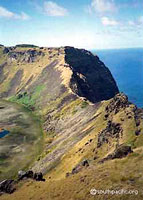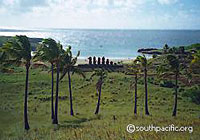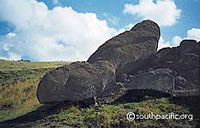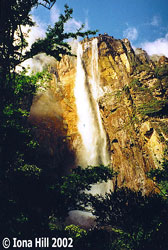Ask me which Pacific island has the most to offer hikers and I’ll probably answer Easter Island. Here on an island 11 km wide and 23 km long you’ll find nearly a thousand ancient Polynesian statues strewn along a powerfully beautiful coastline or littering the slopes of an extinct volcano. Getting there is easy as Easter Island can be included in Oneworld’s round-the-world Explorer airpass, and a fine selection of inexpensive places to stay and eat awaits you.
The legends of Easter Island have been recounted many times. What’s less known is that the island’s assorted wonders are easily accessible on foot from the comfort of the only settlement, Hanga Roa. Before setting out see the sights, however, visit the excellent archaeological museum next to Ahu Tahai on the north side of town (the term “ahu” refers to an ancient stone platform). Aside from the exhibits, the museum has maps which can help you plan your trip.
 The first morning after arrival, I suggest
you climb Easter Island’s most spectacular volcano, Rano
Kau, where Orongo, a major archaeological site, sits on the
crater’s rim. But rather than marching straight up the main
road to the crater, look for the unmarked shortcut trail
off a driveway to the right just past the forestry station
south of town. It takes under two hours to cover the six km
from Hanga Roa to Orongo, but bring along a picnic lunch
and make a day of it. (If climbing a 316-meter hill sounds
daunting, you can take a taxi to the summit for around US$6
and easily walk back later in the day.) Once on top, you’ll
find hiking down into the colourful crater presents no
difficulty. It may also look easy to go right around the
crater rim, but only do so if you’re a very experienced
hiker and have a companion along as shear 250-meter cliffs
drop into the sea from the ridge.
The first morning after arrival, I suggest
you climb Easter Island’s most spectacular volcano, Rano
Kau, where Orongo, a major archaeological site, sits on the
crater’s rim. But rather than marching straight up the main
road to the crater, look for the unmarked shortcut trail
off a driveway to the right just past the forestry station
south of town. It takes under two hours to cover the six km
from Hanga Roa to Orongo, but bring along a picnic lunch
and make a day of it. (If climbing a 316-meter hill sounds
daunting, you can take a taxi to the summit for around US$6
and easily walk back later in the day.) Once on top, you’ll
find hiking down into the colourful crater presents no
difficulty. It may also look easy to go right around the
crater rim, but only do so if you’re a very experienced
hiker and have a companion along as shear 250-meter cliffs
drop into the sea from the ridge.
Another day, rise early and take a taxi to lovely
Anakena Beach at the end of the paved road on the north
side of the island (you should pay under US$10 for the 20
km). A few of the famous Easter Island statues have been
restored at Anakena and you could go for a swim, although
the main reason you’ve come is the chance to trek back to
Hanga Roa around the road-free northwest corner of the
island. You’ll pass numerous abandoned statues lying
facedown where they fell, and the only living creatures
you’re unlikely to encounter are the small brown hawks
which will watch you intently from perches on nearby rocks.
If you keep moving, you’ll arrive back in town in five or
six hours (but take adequate food, water, and sunscreen).
This is probably the finest coastal walk in the South
Pacific.
Almost as good is the hike along the south coast, although you’re bound to run into other tourists here as a paved highway follows the shore. Begin early and catch a taxi to Rano Raraku, the stone quarry where all of the island’s statues were born. This is easily the island’s most spectacular sight with 397 statues in various stages of completion lying scattered around the crater. And each day large tour groups come to Rano Raraku to sightsee and have lunch. However, if you arrive before 9 am, you’ll have the site to yourself for a few hours. When you see the first tour buses headed your way, hike down to Ahu Tongariki on the coast, where 15 massive statues were re-erected in 1994. From here, just start walking back toward Hanga Roa (20 km) along the south coast. You’ll pass many fallen statues and enjoy some superb scenery. Whenever you get tired, simply go up onto the highway and stick out your thumb and you’ll be back in town in a jiffy.
An outstanding 13-km walk begins at the museum and follows the west coast five km north to Ahu Tepeu. As elsewhere, keep your eyes pealed for banana trees growing out of the barren rocks as these often indicate caves you can explore. Inland from Ahu Tepeu is one of the island’s most photographed sites, Ahu Akivi, with seven statues restored in 1960. From here an interior farm road runs straight back to town (study the maps at the museum carefully, as you’ll go far out of your way if you choose the wrong road here).
A shorter hike takes you up Puna Pau, a smaller crater which provided stone for the red topknots that originally crowned the island’s statues. There’s a great view of Hanga Roa from the three crosses on an adjacent hill and you can easily do it all in half a day. A different walk takes you right around the 3,353- meter airport runway, which crosses the island just south of town. Near the east end of the runway is Ahu Vinapu with perfectly fitted monolithic stonework bearing an uncanny resemblance to similar constructions in Peru.
 Easter Island’s moderate climate and scant
vegetation make for easy cross country hiking, and you
won’t find yourself blocked by fences and private property
signs very often. You could also tour the island by
mountain bike, available from several locations at US$10 a
day. If you surf or scuba dive, there are many
opportunities here. A minimum of five days are needed to
see the main sights of Easter Island, and two weeks would
be far better. The variety of things to see and do will
surprise you, and you’ll be blessed with some unforgettable
memories.
Easter Island’s moderate climate and scant
vegetation make for easy cross country hiking, and you
won’t find yourself blocked by fences and private property
signs very often. You could also tour the island by
mountain bike, available from several locations at US$10 a
day. If you surf or scuba dive, there are many
opportunities here. A minimum of five days are needed to
see the main sights of Easter Island, and two weeks would
be far better. The variety of things to see and do will
surprise you, and you’ll be blessed with some unforgettable
memories.
David Stanley is the author of Moon Handbooks Tahiti: Including the Cook Islands http://www.southpacific.org/tahiti.html which also contains a full chapter on Easter Island. His online guide to Easter Island may be perused at http://www.southpacific.org/text/finding_easter.html
Discus this article and give feedback in our online forum


 I was there 2 ½ years ago or so. It was not possible to
visit the Angel Falls independently, so we had to join a
tour. The land is owned by the indigenous people, and they
run the tours. We flew from Caracas to Ciudad Bolivar and
then on to Canaima. From there, we joined about 6 others
and took a succession of curiaras, supremely uncomfortable
dug out canoes, but powered by outboard motor, up the
river. The water is an interesting brown colour – the
colour of tea with all the tannin from the land. We ended
up on Rat Island, along with 100 or so other people all in
different groups, and spent the night here (Isla Ratton
– aptly named) which consisted of about 100 hammocks
strung out in the open under a corrugated iron roof (no
sides) and very primitive bathrooms, hurricane lamps etc. A
very early start the next morning, bread and strong black
coffee, for a short walk/climb – not at all
strenuous, to a viewing point across which we saw the Angel
Falls. The entire group sat on ledges etc gazing across at
the Falls for about 30 minutes, took photos and then went
back down the mountain and returned by curiara to
Canaima.
I was there 2 ½ years ago or so. It was not possible to
visit the Angel Falls independently, so we had to join a
tour. The land is owned by the indigenous people, and they
run the tours. We flew from Caracas to Ciudad Bolivar and
then on to Canaima. From there, we joined about 6 others
and took a succession of curiaras, supremely uncomfortable
dug out canoes, but powered by outboard motor, up the
river. The water is an interesting brown colour – the
colour of tea with all the tannin from the land. We ended
up on Rat Island, along with 100 or so other people all in
different groups, and spent the night here (Isla Ratton
– aptly named) which consisted of about 100 hammocks
strung out in the open under a corrugated iron roof (no
sides) and very primitive bathrooms, hurricane lamps etc. A
very early start the next morning, bread and strong black
coffee, for a short walk/climb – not at all
strenuous, to a viewing point across which we saw the Angel
Falls. The entire group sat on ledges etc gazing across at
the Falls for about 30 minutes, took photos and then went
back down the mountain and returned by curiara to
Canaima. A very Brazilian affair in a very old established English
Lawyers Gallery. After a short presentation, a video on
flat screens round the Gallery, Gilberto Gil picked up his
guitar and this place became the Latin Quarter. He slowly
built up this very different audience of Diplomats, M.P.s,
Environmentalists and Lawyers into a group with many of
them singing along with some of his songs especially the
ones he wrote while in exile in London. The pace quickened
and joining in was Jim Capaldi the well known drummer, but
not with drums but making his mouth a bass and drum rhythm
section and he certainly helped drive it along. One of the
Partners told me the place had never been so alive and with
the wine flowing, the music playing, this did not feel like
a winter night in London but a music bar back in the warmth
of Rio. Sometimes you can travel without going
anywhere.
A very Brazilian affair in a very old established English
Lawyers Gallery. After a short presentation, a video on
flat screens round the Gallery, Gilberto Gil picked up his
guitar and this place became the Latin Quarter. He slowly
built up this very different audience of Diplomats, M.P.s,
Environmentalists and Lawyers into a group with many of
them singing along with some of his songs especially the
ones he wrote while in exile in London. The pace quickened
and joining in was Jim Capaldi the well known drummer, but
not with drums but making his mouth a bass and drum rhythm
section and he certainly helped drive it along. One of the
Partners told me the place had never been so alive and with
the wine flowing, the music playing, this did not feel like
a winter night in London but a music bar back in the warmth
of Rio. Sometimes you can travel without going
anywhere.